Family name: Xyridaceae C. Agardh
Synonym(s): Abolbodaceae Nakai
Common name(s): yellow-eyed grass family
*Number of genera/species: 5/399
List of genera records in GRIN-Global
seed
Fruit a loculicidalloculicidal:
type of capsular dehiscence, opening longitudinally through the locules (compare septicidal)
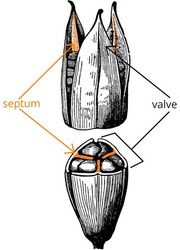 capsulecapsule:
capsulecapsule:
a dry, dehiscent fruit derived from a compound ovary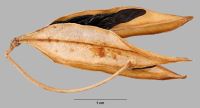 , rarely anomalicidalanomalicidal:
, rarely anomalicidalanomalicidal:
type of capsular dehiscence, opening irregularly
, 4–20 mm long, trigonoustrigonous:
3D shape—having three faces that meet at distinct angles; triangular in outline
to ovateovate:
2D shape—egg-shaped in outline, widest point is towards one end of the organ, the other end tapers gradually, attachment at or near the broad end (compare obovate, ovoid)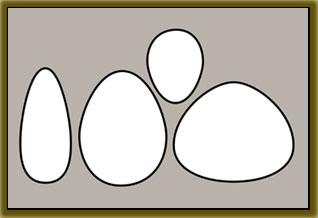 , angledangular:
, angledangular:
2D shape—having sides that meet at acute or obtuse angles
or tereteterete:
approximately circular in cross section; width and thickness approximately equal
 in transection, stylar remnantsstyle base:
in transection, stylar remnantsstyle base:
remnant of a style persistent, sometimes beakedbeak:
persistent, sometimes beakedbeak:
a usually firm, terminal appendage, sometimes tapered , usually persistent perianthperianth:
, usually persistent perianthperianth:
collective term for calyx and corolla of a flower
 encloses fruit, with many seeds. Pericarppericarp:
encloses fruit, with many seeds. Pericarppericarp:
fruit wall or fruit coat
brown or green, shinyshiny:
uniformly reflecting a high proportion of incident light at all angles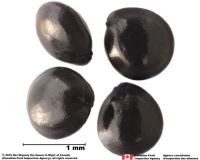 or dulldull:
or dulldull:
reflecting only a low proportion of incident light, with no apparent sheen , woodywoody:
, woodywoody:
texture—consisting mainly of indurate lignified tissues, characteristic of or resembling wood
or chartaceouschartaceous:
papery, papyraceous
to membranousmembranous:
texture—extremely thin, pliable, and fairly tough
in Xyris, wartywarty:
surface relief—distinct, rounded projections that are large relative to the fruit size; tuberculate, verrucose or papillatepapillate:
or papillatepapillate:
surface relief—bearing minute, distinct, broad-based projections, tapering to a rounded apex .
.
Seeds variously shaped, compressedcompressed:
flattened; in grasses, used to denote compression (not necessarily flattened) either laterally or dorsiventrally
or tereteterete:
approximately circular in cross section; width and thickness approximately equal
 in transection, 0.2–9 mm long, sometimes winged. Seed coat red, yellow, black, or brown, shinyshiny:
in transection, 0.2–9 mm long, sometimes winged. Seed coat red, yellow, black, or brown, shinyshiny:
uniformly reflecting a high proportion of incident light at all angles or dulldull:
or dulldull:
reflecting only a low proportion of incident light, with no apparent sheen , leatheryleathery:
, leatheryleathery:
texture—moderately thick, tough, and very pliable
, thin, smooth, reticulatereticulate:
surface relief—netted, raised walls or concave grooves forming a net-like surface pattern with flat, concave, or convex interspaces , striatestriate:
, striatestriate:
surface relief—having fine, parallel lines, grooves or ridges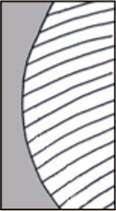 , ridgedridged:
, ridgedridged:
surface relief—raised, thick ridges, sharp edged or rounded, usually in a series that may cover the entire surface , papillatepapillate:
, papillatepapillate:
surface relief—bearing minute, distinct, broad-based projections, tapering to a rounded apex , or ribbedribbed:
, or ribbedribbed:
surface relief—wide, prominent, linear ridges that are generally rounded and longitudinally situated on the surface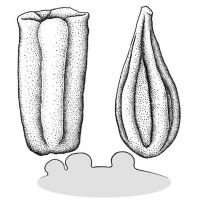 .
.
Seed traits by genus
Abolboda seeds are less than 1.2 mm long, curvedcurved:
(of embryo) linear embryo is curved into an arch or horseshoe with the ends far apart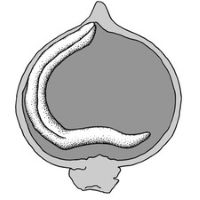 dorsally, and asymmetrically obovoidobovoid:
dorsally, and asymmetrically obovoidobovoid:
3D shape—obovate
. Seed coat is translucenttranslucent:
transmitting light uniformly and diffusely , brown-orange, and obliquely striatestriate:
, brown-orange, and obliquely striatestriate:
surface relief—having fine, parallel lines, grooves or ridges .
.
Aratitiyopea and Achlyphila seeds are less than 1.2 mm long and symmetrically shaped from subglobosesubglobose:
3D shape—almost globose
to ovoidovoid:
3D shape—ovate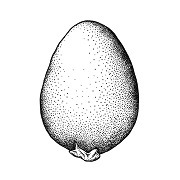 .
.
Orectanthe seeds are 2–4 mm long, laterally compressedcompressed:
flattened; in grasses, used to denote compression (not necessarily flattened) either laterally or dorsiventrally
, mitiform, winged (broadly winged on the embryo or “thumb” side and more narrowly winged on the side opposite the thumb). A crease or line separating the cotyledons from hypocotyl-radicle is present as well as a marginalmarginal:
at, on, or close to the margin or border
notch where cotyledoncotyledon:
a primary leaf of the embryo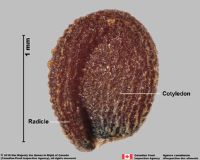 and radicleradicle:
and radicleradicle:
the embryonic root of the embryo tips approach each other.
tips approach each other.
Xyris seeds are typically less than 1.2 mm long, rarely to 3 mm, symmetrically shaped from subglobosesubglobose:
3D shape—almost globose
to cylindriccylindrical:
3D shape—a cylinder, with parallel sides and a circular cross-section; tubular or rod-shaped
, often curvedcurved:
(of embryo) linear embryo is curved into an arch or horseshoe with the ends far apart with scales or hairs at the apicesapex:
with scales or hairs at the apicesapex:
the point farthest from the point of attachment, or the "tip" of an organ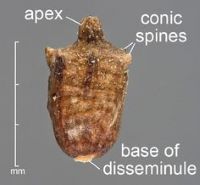 . Seed coat is translucent and longitudinally striatestriate:
. Seed coat is translucent and longitudinally striatestriate:
surface relief—having fine, parallel lines, grooves or ridges .
.
Embryo well developed, broad, straight, basalbasal:
at or pertaining to the point of attachment; (of embryo) embryo occupies one end of the seed
or laterallateral:
(of embryo) embryo lies along the side of the seed, generally towards one end; of, at, or from the side; in grasses, can refer to the sides adjacent to the dorsal and ventral sides
, partially filling seed coat.
Endosperm copious, mealymealy:
loose, dry, and disintegrating in finely granular
pieces like meal or flour
.
| Fruit | |
| Type | capsulecapsule: a dry, dehiscent fruit derived from a compound ovary  |
| Size range | 4–20 mm long |
| Shape(s) | oblongoblong: 2D shape—much longer than broad with nearly parallel sides, corners are rounded 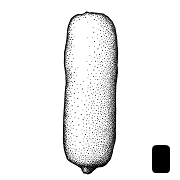 , lanceolatelanceolate: , lanceolatelanceolate:2D shape—lance-shaped; much longer than wide, with widest point below the middle, tapering to the apex (compare oblanceolate) 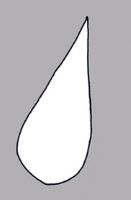 , trigonoustrigonous: , trigonoustrigonous:3D shape—having three faces that meet at distinct angles; triangular in outline , ellipsoidellipsoid: 3D shape—elliptic , ovoidovoid: 3D shape—ovate  |
| Texture | chartaceouschartaceous: papery, papyraceous , membranousmembranous: texture—extremely thin, pliable, and fairly tough , woodywoody: texture—consisting mainly of indurate lignified tissues, characteristic of or resembling wood |
| Surface relief | wartywarty: surface relief—distinct, rounded projections that are large relative to the fruit size; tuberculate, verrucose  , papillatepapillate: , papillatepapillate:surface relief—bearing minute, distinct, broad-based projections, tapering to a rounded apex  |
| Color(s) | brown, green |
| Unique features | Brown or green, wartywarty: surface relief—distinct, rounded projections that are large relative to the fruit size; tuberculate, verrucose  or papillatepapillate: or papillatepapillate:surface relief—bearing minute, distinct, broad-based projections, tapering to a rounded apex  capsulescapsule: capsulescapsule:a dry, dehiscent fruit derived from a compound ovary  , sometimes with persistent perianthsperianth: , sometimes with persistent perianthsperianth:collective term for calyx and corolla of a flower  . . |
| Seed | |
| Size range | 0.2–9 mm long |
| Shape(s) | polygonalpolygonal: angular , oblongoblong: 2D shape—much longer than broad with nearly parallel sides, corners are rounded  , globoseglobose: , globoseglobose:3D shape—more or less spherical 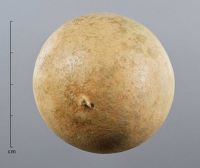 , ovoidovoid: , ovoidovoid:3D shape—ovate  , ellipsoidellipsoid: , ellipsoidellipsoid:3D shape—elliptic , fusiformfusiform: spindle-shaped; broadest at the middle and tapering at both ends  , triangulartriangular: , triangulartriangular:2D shape—three relatively straight sides with distinct corners; more angular than teardrop-shaped  , cylindricalcylindrical: , cylindricalcylindrical:3D shape—a cylinder, with parallel sides and a circular cross-section; tubular or rod-shaped , curvedcurved: (of embryo) linear embryo is curved into an arch or horseshoe with the ends far apart  |
| Surface relief | smooth, reticulatereticulate: surface relief—netted, raised walls or concave grooves forming a net-like surface pattern with flat, concave, or convex interspaces  , striatestriate: , striatestriate:surface relief—having fine, parallel lines, grooves or ridges  , ridgedridged: , ridgedridged:surface relief—raised, thick ridges, sharp edged or rounded, usually in a series that may cover the entire surface  , papillatepapillate: , papillatepapillate:surface relief—bearing minute, distinct, broad-based projections, tapering to a rounded apex  , ribbedribbed: , ribbedribbed:surface relief—wide, prominent, linear ridges that are generally rounded and longitudinally situated on the surface  |
| Color(s) | red, yellow, black, brown |
| Other | |
| Embryo | well developed, broad, straight, basalbasal: at or pertaining to the point of attachment; (of embryo) embryo occupies one end of the seed or laterallateral: (of embryo) embryo lies along the side of the seed, generally towards one end; of, at, or from the side; in grasses, can refer to the sides adjacent to the dorsal and ventral sides , partially filling seed coat |
| Nutritive tissue | endosperm copious, mealymealy: loose, dry, and disintegrating in finely granular pieces like meal or flour |
Pantropical to warm temperate.
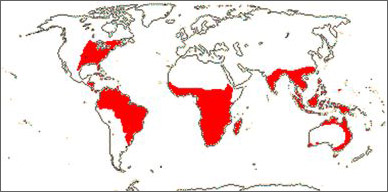
Distribution map courtesy of Angiosperm Phylogeny Website.
Baskin and Baskin 2021Baskin and Baskin 2021:
Baskin C and Baskin J. 2021. Relationship of the lateral embryo (in grasses) to other monocot embryos: A status up-grade. Seed Science Research 31 (3): 199-210. doi:10.1017/S0960258521000209; Dahlgren et al. 1985Dahlgren et al. 1985:
Dahlgren RMT, Clifford HT, and Yeo PF. 1985. The families of the monocotyledons: structure, evolution, and taxonomy. Springer-Verlag, Berlin. 520 pp.; Flora of North America Editorial Committee 1993+Flora of North America Editorial Committee 1993+:
Flora of North America Editorial Committee, eds. 1993+. Flora of North America North of Mexico [Online]. 22+ vols. Flora of North America Association, New York and Oxford. Accessed January-March 2024. URL: http://beta.floranorthamerica.org.; Kirkbride et al. 2006Kirkbride et al. 2006:
Kirkbride JH, Jr, Gunn CR, and Dallwitz MJ. 2006. Family guide for fruits and seeds, vers. 1.0. Accessed September 2020-January 2022. URL: https://nt.ars-grin.gov/seedsfruits/keys/frsdfam/index.cfm .; Kral 1988Kral 1988:
Kral R. 1988. The genus Xyris (Xyridaceae) in Venezuela and contiguous Northern South America. Annals of the Missouri Botanical Garden 75 (2): 522-722. https://doi.org/10.2307/2399434; Kral 1992Kral 1992:
Kral R. 1992. A treatment of american Xyridaceae exclusive of Xyris . Annals of the Missouri Botanical Garden 79 (4): 819-885. https://doi.org/10.2307/2399721; Kubitzki et al. 1990+Kubitzki et al. 1990+:
Kubitzki K et al., eds. 1990+. The families and genera of vascular plants. 7+ vols. Berlin etc.; Lock 1999Lock 1999:
Lock JM. 1999. Xyridaceae. In Beentje HJ and Whitehouse CM, eds. Flora of Tropical East Africa. Vol 195. AA Balkema, Rotterdam, Netherlands. 24 pp.; Stevenson and Loconte 1995Stevenson and Loconte 1995:
Stevenson DW and Loconte H. 1995. A cladistic analysis of monocot families. In: Rudall PJ, Cribb PJ, Cutler DF, and Humphries CJ, eds. Monocotyledons: Systematics and Evolution. Royal Botanic Gardens, Kew.; Thiselton-Dyer 1896–1897Thiselton-Dyer 1896–1897:
Thiselton-Dyer WT. 1896–1897. Flora capensis: being a systematic description of the plants of the Cape colony, Caffraria, & Port Natal (and neighbouring territories). Vol. 6. L. Reeve, Kent UK. 563 pp. https://doi.org/10.5962/bhl.title.821 ; Zhengyi et al. 2004+Zhengyi et al. 2004+:
Zhengyi W, Raven PH, and Deyuan H. 2004+. Flora of China [online]. 25 vols. Science Press, Beijing China & Missouri Botanical Garden, St. Louis USA. Accessed January–March 2024. http://flora.huh.harvard.edu/china/
*The number of genera and species is based on Christenhusz and Byng 2016Christenhusz and Byng 2016:
Christenhusz MJM and Byng JW. 2016. The number of known plant species in the world and its annual increase. Phytotaxa 261 (3): 201-217. https://doi.org/10.11646/phytotaxa.261.3.1, which may differ from the number of genera in GRIN-Global.